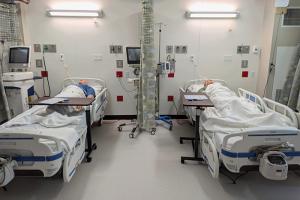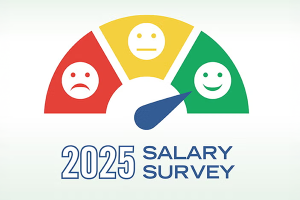Joint Commission shares more details about Accreditation 360
In effort to better align with the Centers for Medicare & Medicaid Services (CMS), The Joint Commission recently announced that it made significant updates to its accreditation manual for hospitals and critical access hospitals (CAHs).
The changes, part of The Joint Commission’s new survey approach dubbed “Accreditation 360: The New Standard,” will go into effect Jan. 1, 2026. The move not only impacts the Joint Commission’s accreditation manual but also introduces new resources to foster a mindset of continuous survey readiness among its accredited facilities (see related article below).
Although the changes are significant, Ken Grubbs, R.N., DNP, MBA, executive vice president of accreditation and certification operation and chief nursing officer at Joint Commission, says that Joint Commission-accredited facilities can be assured that the changes will reduce burden, not increase it.
“The survey process under Accreditation 360 will become more streamlined, collaborative and outcomes focused — most noticeably, through the updated accreditation manual, which provides greater clarity in identifying CMS-directed Conditions of Participation (CoPs) and Joint Commission’s National Performance Goals (NPGs),” Grubbs says. “Health care organizations and staff will have a unified, user-friendly resource that integrates requirements into one coherent framework — reducing confusion, duplication and variability in practice.”
The new accreditation manual is a streamlined approach that creates clear delineation between Joint Commission standards that directly align with the CoPs — which health care organizations must comply with to qualify for Medicare reimbursement — and Joint Commission standards that go above the CoPs.
Grubbs says that the program is first rolling out to hospitals and CAHs, and the accrediting organization (AO) plans to introduce the program to other health care settings beginning in 2026 and moving forward. It will share more information on the timeline for each program as it becomes available.
Transparency in requirements
It’s important to note that the revised accreditation manual for hospitals and CAHs does not introduce any new standards or eliminate any CMS requirements. Instead, it builds upon previous efforts that started in 2022 when Joint Commission began evaluating its standards against the CoPs, resulting in the elimination of 400 standards across several accreditation programs in 2023 that were deemed duplicative or outdated. This most recent move continues in that mode, resulting in the further removal of 714 requirements from its hospital program and 649 from the CAH program.
It also simplifies the accreditation manual chapters.
For instance, the former “Environment of Care and Life Safety chapters have been replaced with a new Physical Environment Chapter to match the structure of the CoPs,” Grubbs says. The Infection Control and Emergency Management chapters remain standalone chapters but have been streamlined to align with the CoPs. Below each standard, the manual lists elements of performance (EPs) and the applicable CoPs from which the standard was derived. All standards and EPs that go above CMS requirements are consolidated into the new NPG Chapter.
Grubbs says many EPs also have been simplified to eliminate confusion.
“For example, Joint Commission standards previously featured three lengthy and redundant requirements related to inspecting, testing and maintaining medical equipment,” Grubbs explains. “These were replaced with one requirement, with the same expectations, that simply states: ‘The hospital maintains essential equipment in safe operating condition.’”
In a move of transparency, and to help Joint Commission-accredited organizations prepare for the 2026 effective date, the AO has released several publicly available resources on its Accreditation 360 webpage. This includes its accreditation requirements for hospitals and CAHs as well as crosswalks that display the CoPs for each program and their Joint Commission-equivalent EPs. Crosswalk compare reports are also public so that users can examine previous Joint Commission EPs alongside the new EPs. Joint Commission also shared disposition reports to track the previous locations of EPs to their new locations in the updated accreditation manual. Finally, the resource page also offers survey process guides (replacing the survey activity guides) so that organizations and surveyors can speak the same language.
“By definition, accreditation is about enabling and affirming the highest standards of health care quality and patient safety,” Grubbs says. “But we also recognize that accreditation is about supporting, troubleshooting and leading-practice sharing in a way that doesn’t add to the already heavy burden on health care organizations today. Accreditation 360 was developed based on this exact thinking: improving the technical side of accreditation and surveys, while eliminating waste and redundancy to reduce the burden on already overtaxed health care organizations.”
Grubbs says that facilities managers or anyone at a Joint Commission-accredited or certified health care organization can reach out to their Joint Commission account executive for more information or submit a question to the AO’s Standards Interpretation Team for support.
Preparing the field
Leaders from Joint Commission also will share updates on this new program at the Health Care Facilities Innovation Conference™ taking place July 27-30 in Columbus, Ohio. The annual conference is put on by the American Society for Health Care Engineering (ASHE).
Tim Markijohn, field director in the hospital program for the Life Safety Code surveyors at The Joint Commission, and Jim Grana, a field director in the division of accreditation and certification operations at The Joint Commission, will lead two sessions on the topic.
The breakout session “The Joint Commission: Survey of the Future” will take place July 30 at 11:30 a.m. and will detail the new Physical Environment Chapter’s structure, numbering and identification convention. The speakers also will discuss how the consolidated standards will help reduce the paperwork burden of compliance.
In a post-conference session taking place on the same day at 1 p.m., “Lunch and Learn with The Joint Commission,” Markijohn and Grana will share tips on survey preparation and documentation and review common physical environment deficiencies. Attendees can also ask questions and get answers about the Joint Commission changes directly. To submit questions for the Lunch and Learn beforehand, click here. And to register for the conference, click here.
Because the new Accreditation 360 program does not add any new requirements, Leah Hummel, AIA, CHFM, SASHE, CHC, CHOP, senior associate director, ASHE, Regulatory Affairs, says one of the biggest changes hospitals and CAHs accredited by Joint Commission are likely to encounter is how deficiencies are cited and the standard and EP number they are cited under.
“We have been analyzing and comparing the old Joint Commission standards to the new ones, and much of what they've done with this change is simply brought everything under much broader categories,” Hummel explains. “For example, there's a new standard titled PE.03.01.01, EP3, which says, ‘The hospital meets the applicable provisions of the Life Safety Code.’ That's very broad. In the past, there were individual EPs listed under the standards that correlated to each chapter of the National Fire Protection Association’s NFPA 101®, Life Safety Code®. In this new format, that has changed. However, everything that was a deficiency before is still going to be a deficiency now, but it’s just going to fall under this much broader category.”
In addition to scheduling breakout sessions specific to the topic at its upcoming Health Care Facilities Innovation Conference, ASHE also has updated the life safety and care environment modules included in its Physical Environment Survey Readiness Program to reflect the Joint Commission changes. The program also includes an emergency management module that ASHE is working to update.
The program also is offered as a Live Online Training (LOT) and an in-person course to teach attendees how to be survey-ready no matter which AO or survey process they choose. The Physical Environment Survey Readiness Program is designed for hospital settings only and is applicable to those surveyed by the major AOs, including the Joint Commission, DNV Healthcare USA Inc. and the Accreditation Commission for Health Care (ACHC), as well as facilities that are surveyed directly by CMS.
The updated program includes the redesigned ASHE Compliance Tracker™, which will help attendees navigate key codes, regulations and standards. The tracker crosswalks the standards from the Joint Commission (both the old and new standards), DNV and ACHC, tying them directly to the CMS CoPs and NFPA references they are derived from. (See an example of the ASHE Compliance Tracker below.) The tracker includes pre-compiled, relevant regulatory references to save users time in looking up the references themselves. The program's other materials, including a course guide, workbook and other tools, also have been updated. Visit ASHE’s website for a current schedule of the Physical Environment Survey Readiness Program or to inquire about hosting the program on-site.
The updated ASHE Compliance Tracker™ is an easy-to-use reference tool created for ASHE's Physical Environment Survey Readiness Program
Graphic courtesy of ASHE
Hummel says the Physical Environment Survey Readiness Program is especially helpful for Joint Commission-accredited hospitals as they update their compliance documentation to align with the revised standards and learn to navigate the CMS requirements without a plethora of EPs.
“Many organizations list Joint Commission standards and EPs in their policies or procedures when documenting their inspection, testing and maintenance requirements,” Hummel says. “They will want to start updating those.”
However, she also says that the Joint Commission has confirmed that organizations will be given grace even if their documentation still references the old standards structure after the 2026 effective date.
“We've gotten word from the Joint Commission that their intent is to survey organizations based on what's required, whether that be the content of their policy or the exact testing or inspection requirements. Those are the factors they will be judged on,” she explains. “It will take some time for organizations to revise their documentation according to the new numbering system. But as long as they're compliant with the requirements themselves there will be forgiveness while they make those changes.”
Related article // Changes come full circle at the Joint Commission
In addition to major revisions to its accreditation manual that align with the Centers for Medicare & Medicaid Services Conditions of Participation, the Joint Commission’s “Accreditation 360: The New Standard” introduces other components designed to foster a continuous survey-ready mindset.
- Continuous Engagement model. This voluntary option offers the opportunity for ongoing support to drive successful safety and quality practices and perpetual survey readiness. The Joint Commission says it is currently piloting this aspect of the program and refining how it interacts with health care organizations between surveys.
- Certifications focused on outcome measures. To shift the focus from observation of structure and process to outcome measures, The National Quality Forum (NQF), an affiliate of the Joint Commission, is introducing a next-generation certification program, starting with four key areas prioritized by patients, clinicians, health systems, payers and purchasers: maternity care, hip and knee procedural care, spine procedural care and cardiovascular procedural care.
- Broadened resources. The Joint Commission is currently piloting its new Survey Analysis For Evaluating STrengths (SAFEST) Program to recognize leading practices at accredited organizations and to support the dissemination of safety and quality improvement insight. As part of SAFEST, Joint Commission surveyors will identify performance strengths during surveys, and organizations may be asked to further develop these strengths into leading practices shared with all Joint Commission-accredited organizations. This will ultimately evolve into a database of leading practices where surveyors can access organizations’ performance strengths for industry-wide collaborative learning.
“Joint Commission-accredited facilities should view Accreditation 360 not as a checklist to prepare for, but as a shift toward continuous readiness,” says Ken Grubbs, R.N., DNP, MBA, executive vice president of accreditation and certification operation and chief nursing officer at Joint Commission. “The goal is to reduce burden while maintaining a strong focus on quality and safety.
“Aside from the updated accreditation manual and SAFEST, which will be incorporated into our accreditation programs, all other components of Accreditation 360 are voluntary — so organizations can choose what to adopt based on their unique needs,” Grubbs continues. “This flexibility allows facilities to engage with tools like SAFEST and Continuous Engagement model at their own pace, while still aligning with a modernized, outcomes-driven approach to accreditation.”
Visit the Joint Commission’s Accreditation 360 webpage to learn more.





